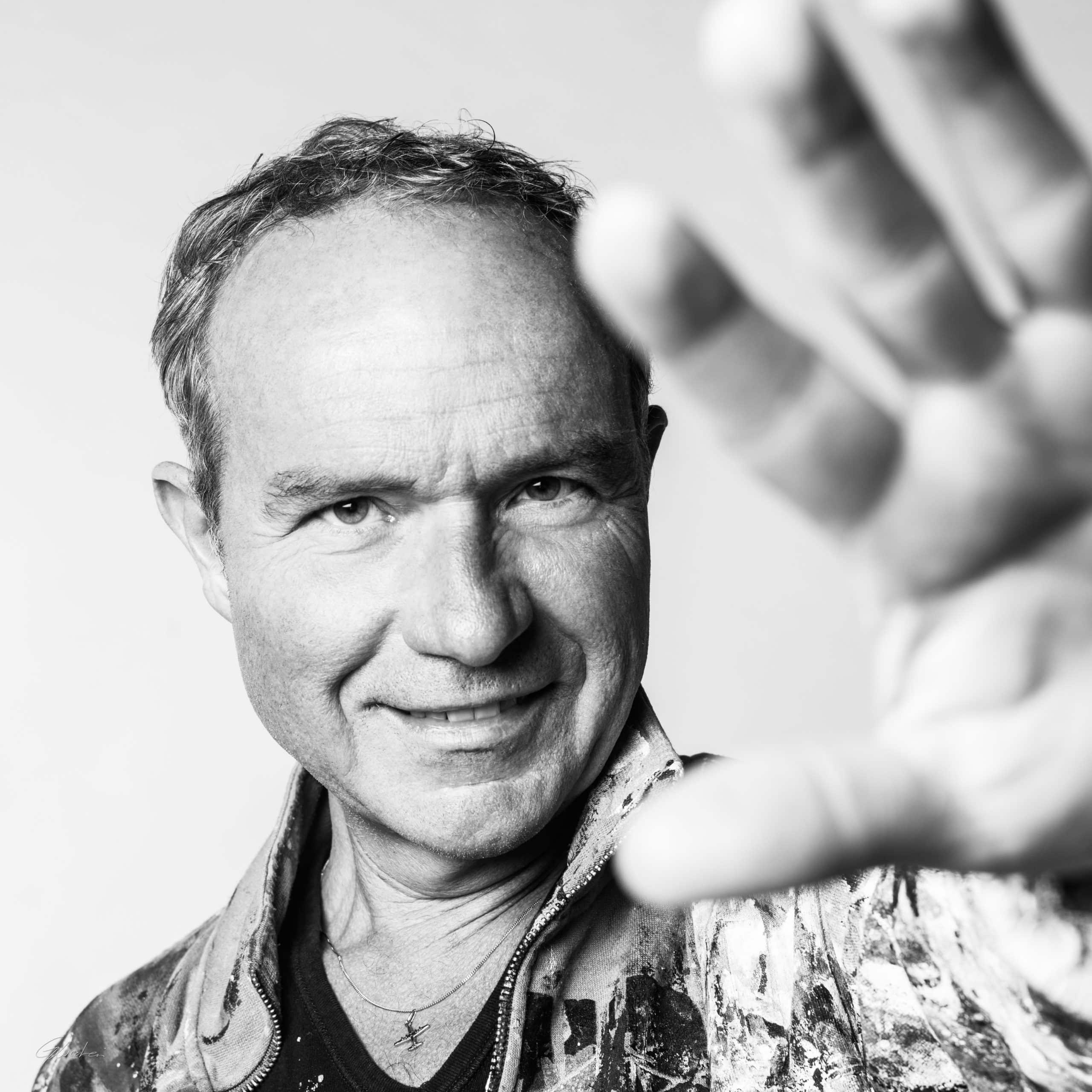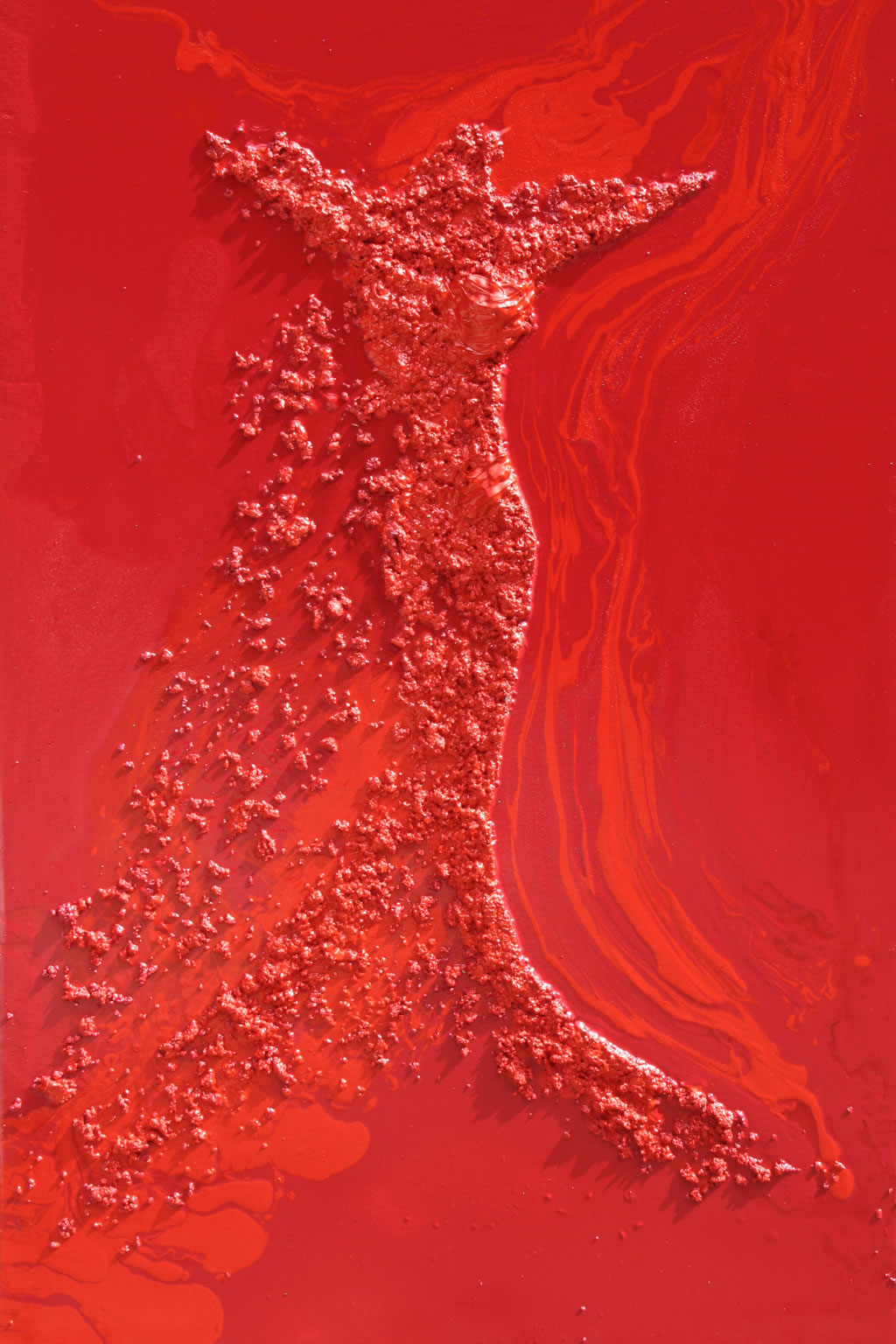MONTAGNAC’S BIOGRAPHY

MONTAGNAC, At the Heart of the Matter
By Guillaume Morel
Journalist and Art critic
Color meeting form : the title of one of his very first works of art almost carries the weight of a manifesto. This small quadriptych painting, composed of slightly raised panels, within a reduced chromatic range of two colors (white and red), announces the founding principles of a vivid vocabulary that has, since the start, continued to evolve following the path of monochrome and, above all, monumentality.
Today, Patrick Montagnac exhibits all over the world, including throughout France, and in Monaco, Tokyo, New York, Geneva, and London to name a few. In 2020, he was the guest of the Matisse Museum in Le Cateau-Cambrésis and had a taste for producing flash exhibitions in pop up galleries (in March 2023 at L’Arbre Blanc, in Montpellier, where he presented around forty paintings of different formats. Each time, he creates the event by immersing the spectator in the thickness of the material and the intensity of the color.
Montagnac’s art revolves around a narrow number of subjects: the female body, islands, trees, the aquatic world …Each theme gives rise to an open series, conceived as a “collection” which will grow over time. “The paintings complement each other, answer to each other, and go hand in hand”, explains the artist.
Montagnac has been doing nonstop trips and meetings. But when he is home, he works in the peace and quiet of his Art Deco-style house where he set up a workshop tailored to the (dis)proportion of his projects. His artistic practice, which combines concrete and pigments, is eminently physical. Like a sculptor, his work not only engages the hand, but the entire body.
A life force
Everything starts with a simple pencil stroke, scribbled on a notebook. Then, with charcoal, Patrick Montagnac outlines his composition on the canvas leaning against the wall. Immediately, the gesture injects momentum right away. The artist then works on the ground to give shape and substance to his concrete shape. Once this phase is finalized, it’s time to paint with a knife.
Around the surface, Montagnac paints backgrounds that appear monochrome, without ever being uniform. Almost invisible lines dance within the color, subtle nuances come alive on the surface. The energy forces circulate. The eyes, initially captivated by the main motif, ultimately get lost in the pictorial universe, all the way to the frontiers of the abstraction.
The painter gets inspired by what he lives, what he sees. By these stratified, eroded landscapes he observed as a child in the valley of the Lot. Originally from Aveyron, Patrick Montagnac was very quickly attracted to far away lands. He earned his pilot license at age 17, which explains the islands seen from a plane, a blend of real cartography (for example with Corsica, Guadeloupe,Fidji) and imaginary territories. The sensual bodies of his Homages to Women, as if emerging from the material, talk of memory, trace, and footprint. As for his Trees, solidly rooted, they hide their vulnerability behind their apparent power.
Whatever the subject might be, the work of Montagnac evokes the passage of time, the fragility of beings, of things, of nature. “In 2008, following a wrong medical diagnosis, my perception of life changed. The awareness of its ephemeral nature took over. Painting is here to keep a trace of what disappears,” he explains. Patrick Montagnac had been painting for a few years by this point, but it was when his existence almost toppled over that he decided to devote himself entirely to his art.
Toward the monumental
If he invented a technique and a style that only belongs to him and today makes his signature, Montagnac does not hide his influences. “Van Gogh is the first painter who fascinated me with his thick brushstrokes and the explosive strength of his colors,” he says. The material-focused works of Paul Rebeyrolle and Antoni Tàpies encouraged him to experiment with depth and concrete. As for his taste for black, he owes it to the most famous “Aveyronnais”, Pierre Soulages. “I had a real revelation in 2012, during an exhibition in the Museum of Fine Arts in Lyon,” the artist recalls. Since then, he envelops his Trees and his Angels Wings in deep and textured black, that is matte or silky, smooth or rough, letting the light to caress volumes, underline the sharpness, giving life to the folds and ridges of the material.
Lastly, how can we forget Henri Matisse? In 2020, Patrick Montagnac was invited by the Matisse museum in Le Cateau-Cambrésis to participate in a collective exhibition of contemporary art on the occasion of the 150th anniversary of the painter’s birth. Montagnac had the honor of an entire room, where he presented four imposing masterpieces: three of them dedicated to the island themes (namely Corsica and Tahiti) and trees, and the fourth is on a huge tryptic in black monochrome. “The challenging task was to maintain the dynamism on such large surfaces. This dialogue with Matisse made me grow,” he confides.
In less than fifteen years of career, the path traveled by Montagnac is impressive. From his early acrylic series in the early 2010s (Flower Bouquets, Delicacies…) to his recent polyptychs, his painting never ceased to gain mastery, deploying his power in increasingly monumental formats.
Bolstered by his success, he is now sought all over the world. Collectors, executive business leaders, hotel curators, museum institutions and more all commission his works. “ It pushes me to get out of my comfort zone, to explore new paths while staying faithful to who I am. Only a work that is sincere and authentic will be a successful work,” the artist concludes.
By Guillaume Morel
Journalist and Art critic
L’ A R T I S T E

Montagnac, au cœur de la matière
par Guillaume Morel
Journaliste & critique d’art
La couleur à la rencontre de la forme : le titre d’une de ses toutes premières œuvres aurait presque valeur de manifeste. Ce petit quadriptyque composé de panneaux légèrement en relief, dans une gamme chromatique réduite à deux couleurs (le blanc, le rouge), annonce les principes fondateurs d’un vocabulaire plastique qui, depuis, n’a cessé de se développer en suivant les voies du monochrome et surtout, de la monumentalité.
Aujourd’hui, Patrick Montagnac expose partout dans le monde, en France, à Monaco, à Tokyo, à New York, à Genève, à Londres…. En 2020, il a été l’invité du musée Matisse au Cateau-Cambrésis, et a le goût des expositions flash organisées dans des galeries éphémères (en mars 2023 à L’Arbre blanc, à Montpellier, où il présentait une quarantaine de toiles de petits et grands formats). À chaque fois il crée l’événement, immergeant le spectateur dans l’épaisseur de la matière et l’intensité de la couleur.
L’art de Montagnac s’articule autour d’un nombre resserré de sujets : le corps féminin, les îles, les arbres, le monde aquatique… Chaque thématique donne lieu à une série ouverte, envisagée comme une « collection » amenée à s’enrichir au fil du temps. « Les tableaux se complètent, se répondent, se conjuguent », explique l’artiste.
Montagnac enchaîne les voyages et les rendez-vous. Mais lorsqu’il est chez lui, il travaille au calme, dans sa maison de style Art déco où il a aménagé un atelier à la (dé)mesure de ses projets. Sa pratique artistique, qui mêle béton et pigments, est éminemment physique. Comme celle d’un sculpteur, son œuvre n’engage pas seulement la main, mais le corps entier.
Une énergie vitale
Tout commence par un simple croquis, griffonné sur un cahier. Puis, au fusain, Patrick Montagnac esquisse sa composition sur la toile, adossée au mur. Rapide, le geste insuffle d’emblée une dynamique. L’artiste travaille ensuite par terre, pour donner corps à sa forme en béton. Une fois celle-ci finalisée, vient le temps de la peinture, au couteau.
Autour du relief, Montagnac peint des fonds en apparence monochromes, sans être jamais uniformes. Des lignes presque invisibles dansent dans la couleur, d’infimes nuances animent la surface. Les énergies circulent. Le regard, d’abord happé par le motif principal, se perd dans l’univers pictural, jusqu’aux frontières de l’abstraction.
Le peintre s’inspire de ce qu’il vit, de ce qu’il voit. De ces paysages stratifiés, érodés, qu’il observait enfant dans la vallée du Lot. Natif de l’Aveyron, Patrick Montagnac a très vite été attiré par des mondes plus lointains. Il a obtenu son brevet de pilote à l’âge de 17 ans. D’où ses Îles vues d’avion, entre cartographies réelles (Corse, Guadeloupe, Fidji…) et territoires imaginaires. Les corps sensuels de ses Hommages aux femmes, comme surgis de la matière, parlent de mémoire, de trace et d’empreinte. Quant à ses Arbres solidement enracinés, ils cachent leur vulnérabilité derrière leur apparente puissance.
Quel que soit le sujet, les œuvres de Montagnac évoquent le passage du temps, la fragilité des êtres, des choses, de la nature. « En 2008, à la suite d’un diagnostic médical erroné, ma perception de la vie a changé. La conscience de son caractère éphémère a pris le dessus. La peinture est là pour garder une trace de ce qui disparaît », explique-t-il. Patrick Montagnac peignait déjà depuis quelques années, mais c’est à ce moment où son existence a failli basculer qu’il a décidé de se consacrer exclusivement à son art.
Vers le monumental
S’il a inventé une technique et un style qui n’appartiennent qu’à lui et font aujourd’hui sa signature, Montagnac ne cache pas ses influences. « Van Gogh est le premier peintre qui m’a fasciné, par sa touche épaisse et l’expressivité de ses couleurs », dit-il. Les œuvres matiéristes de Paul Rebeyrolle et d’Antoni Tàpies l’ont encouragé à expérimenter le relief et le béton. Quant à son goût pour le noir, il le doit au plus illustre des Aveyronnais, Pierre Soulages. « J’ai eu une véritable révélation en 2012, lors d’une exposition au musée des Beaux-Arts de Lyon », se souvient l’artiste. Depuis, il enveloppe ses Arbres et ses Ailes d’ange d’un noir profond et texturé, mat ou soyeux, lisse ou rugueux, laissant la lumière caresser les volumes, souligner les reliefs, donner vie aux plis et replis de la matière.
Enfin, comment ne pas évoquer Henri Matisse ? En 2020, Patrick Montagnac est sollicité par le musée Matisse du Cateau-Cambrésis pour participer à une exposition collective d’art contemporain à l’occasion du 150e anniversaire de la naissance du peintre. Il a l’honneur d’une salle entière, où il présente quatre œuvres magistrales : trois d’entre elles sont dédiées aux thèmes des îles (la Corse et Tahiti) et de l’arbre, la quatrième est un immense diptyque en monochrome noir. « La difficulté était de tenir la dynamique sur d’aussi grandes surfaces. Ce dialogue avec Matisse m’a fait grandir », confie-il.
En moins d’une quinzaine d’années de carrière, le chemin parcouru par Montagnac est impressionnant. De ses premières séries à l’acrylique à l’aube des années 2010 (Bouquets de fleurs, Gourmandises…) à ses récents polyptiques, sa peinture n’a cessé de gagner en maîtrise, déployant sa puissance en des formats de plus en plus monumentaux.
Fort de son succès, il est aujourd’hui sollicité dans le monde entier. Collectionneurs, chefs d’entreprise, directeurs d’hôtel, institutions muséales… lui passent commande. « Cela me pousse à sortir de ma zone de confort, à emprunter des voies nouvelles tout en restant fidèle à ce que je suis. Seule une œuvre sincère, authentique, sera réussie », conclut l’artiste.


